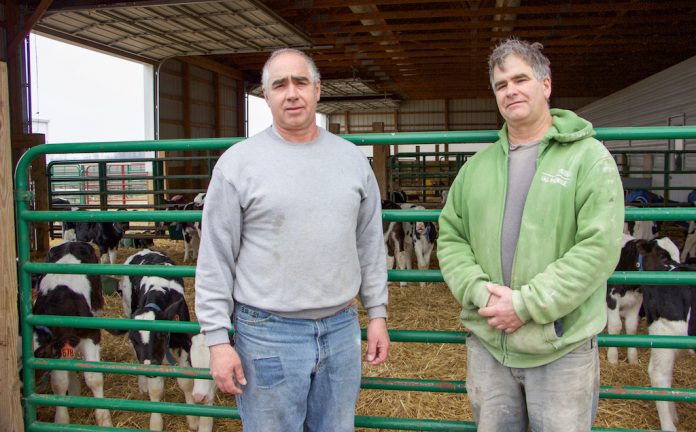
BELLEVUE, Ohio — It was time. If fourth-generation farmers Kevin and Steven Erf were going to keep their Huron County farm strong, they knew they needed to make an upgrade.
Two years ago, the Erf brothers went from a traditional calf hutch feeding operation to a fully automated calf weaning facility. The decision made a huge difference in cutting labor for the small family operation and has strengthened their skills as farm managers.
“Our roles have shifted from laborers to managers,” said Kevin. “You still have to look at the calves every day and check the machines.”
But transitioning away from the hutches has made the winter chores less daunting and increased the efficiency of their operation.

Start to finish
Erf Family Farms has seen a lot of changes over the years: transitioning from a dairy to a Holstein beef finishing operation in 2008, to moving in to the automated facility in March 2016.
The Erfs purchase calves from the Creston sale barn at 3 to 5 days old. For the first seven to 10 days, calves are penned individually so they learn to eat aggressively from a bottle.
“They have to learn to eat aggressively before they can eat off the machine,” said Kevin. The Erf brothers’ mother, Minetta, enjoys hand feeding the new bottle babies.
After about 10 days, the calves are moved into a community pen of around 20 to 25 calves grouped by age, and given a collar with an electronic transmitter.
Automated

The transmitter serves as an identification tag and helps the automated calf feeder recognize and record each individual calf.
In the first community pen, calves learn to use the automated feeder. Calves walk into the feeding stall and drink from the nipple attached to the machine in the wall.
The sensor, located next to the nipple, reads the calf’s collar as it walks up to the machine and prepares the right mixture of milk replacer and water for the individual calf.
Kevin said during the early stages, they use a higher percentage of milk replacer mixed with water to boost the calf’s immune system and promote growth. As the calf gets older, more water is added for weaning.
“Our main goal is to raise healthy, fat cattle,” said Kevin. The machine also regulates how fast the calf can drink. Once the calf is done drinking, the machine cuts off the air flow to the nipple.
“Younger calves have an insatiable urge to suck,” said Kevin. The younger calves will often chew and play with the nipple, but they won’t be able to suck in any extra air into their stomachs, he explained.
The feeder also regulates how many times a day the calf can drink. If a calf enters the machine before it is time to eat again, the machine will not dispense any milk and the calf will eventually walk away.

Setup
The calf barn is divided into three community pens, where calves are rotated as they get older. Each pen has access to an outdoor paddock for exercise as well as a straw-bedded indoor pen.
Kevin said even in the cooler temperatures, the calves enjoy being outside. The younger calves are fitted with calf coats to protect them from the cold.
Calves are also given access to pellets in the second age group and by the last age group, they are given small amounts of hay before they are weaned at 60 days.
The steers are then moved to a finishing facility at another property owned by the Erfs, where they are fed a diet of fermented feeds — corn silage and wheatlage — grown by the Erfs, and wet distillers.
The Erfs feed out around 500 head per year and the finished steers are marketed to JBS.
Hygiene

The Erf brothers are conscious about the cleanliness of their facility and the health of their calves. “We are big believers in Clorox wipes,” said Kevin.
Twice a day the automated feeder will perform a self clean and the Erfs replace all hoses on a quarterly basis.
Since switching from a hutch feeding operation to the new barn, Kevin said they have noticed an overall improvement in the health of their calves.
“I think we are on target for under 3 percent death loss,” he said, which he attributes to the increased management practices on the farm.











